

教 案
授课单位: |
外国语言文学学院(部) 英语 系 |
课程名称: |
微格教学 |
主讲教师: |
胡爱晶 |
授课对象: |
2019级 英语专业 |
学年学期: |
2021-2022学年第二学期 |
微格教学课程基本信息
课程编号: |
315030 |
课程类别: |
专业必修课 |
学 分: |
2 |
学 时: |
36:(理论18 实践:18 ) |
一、课程教学目标
本课程面向的授课对象是大三年级学生,上一学期他们已经修完了英语教学法课程,所以本学期的微格教学是对教学理念与实践相结合的教学技能实践课程。是英语教育方向学生的专业必修课程,对学生教学技能的生成具有不可或缺的重要价值。
1.知识目标
(1) 了解教师职业的意义和专业化特点,树立符合国家英语课程标准的教师职业观;
(2) 了解外语语言观和语言学习观对英语教师教学观念和行为的影响;
(3) 明确国家英语课程改革的理念和目标,了解课程改革对教师提出的要求;
2.能力目标
(1) 了解教学设计原则和方法,明确构成教学设计各个组成部分,以及应该注意的问题;
(2) 以教学基本理论和课程标准为指导,设计基于现行中学英语教材的听说、阅读、写作、语法、词汇等不同课型的教案,教学材料分析到位,教学目标设计可操作、可检测,教学过程设计合理、教学评价设计有效,并能对自己的教学设计进行论证;
3.素质目标
(1)基于真实的教学材料进行独立的教材分析,确定教学的重难点。
(2)通过预先观课,思考教学技巧有能力独立备课、讲课和说课;
(3)初步形成自己的教学理念,将先进的教学理念和方法运用到教学设计之中。
(4)培养出符合时代需要,热爱党,热爱国家,热爱人民,热爱教育,热爱学 生的有社会责任感的中小学英语教师。
二、课程教学内容
为本学期教学内容按教学周设置如下:
(1) Requirements
(2) Introduction to Micro-teaching
(3) Instructions and Grouping
(4) Demo class
(5) Discipline in language classroom
(6) Dealing with errors
(7) Questioning
(8) Demo class for questioning
(9) Teaching pronunciation
(10) Teaching grammar
(11) Teaching Vocabulary
(12) Teaching listening
(13) Teaching Speaking
(14) Teaching Reading
(15) Teaching Writing
(16) Learner Differences
(17) Teaching learning strategies
(18) Revision or exam
三、课程考核方式
《微格教学》在考核中更加强调了学生的过程性评价。考核内容主要由六部分构成:
总成绩=过程性评价 60% +终结性评价40%
* 课前慕课学习汇报陈述或教学(导课环节)活动设计10%
* 课堂讨论10%:或学习通平台按发言或发贴次数(至少10次以上)和内容质量进行综合评分。
* 学习通平台教学视频、课件自主观摩10%
* 慕课平台或学习通平台平时测试成绩 10%
* 期末随堂微格教学展示 20%:学生自选中、小学现行教材。准备20分钟教学环
节完整的讲课和10钟说课内容。
* 期末随堂考试 40%
四、课程选用教材及参考资料
课程选用教材:
《英语教学法教程》,主编:王蔷, 高等教育出版社 书号(ISBN):
9787040186796,普通高等教育“十五”国家级规划教材,第二版,2006.6
主要参考资料
(1) 义务教育英语课程标准(2011年版)
(2) 《新世纪师范英语系列教材》 作者:盖瑟著 出版社:上海外语教育出版社2013-09
(3) 中学英语教学设计(网络课程)
https://www.icourses.cn/sCourse/course_4519.html
第一模块(Requirements)教学设计
一、教学内容:Requirements for the course
二、讲授学时:2
三、教学目标
By the end of the lesson, students will be able to get to know :
(1) General rules for the class
(2) Detailed requirements specific activities
(3) Rubics for evaluation
(4) Analysis of a demo class
三、教学主要知识点及教学重点、难点
(1) Setting training goals
(2) Observing a video presentation of the skills
(3) Analyzing and discussing the skills
五、教学过程与教法设计
(1) PPP model
(2) Discussion questions followed
六、课程思政映射与融入点
Moral value: set a positive mindset and goal for being a good foreign language teacher.
七、课后任务
Write a short plan about how you would like to develop your teaching skills based on today's lesson,for example , how you would like to encourage students to participate more or how you can design the activities so that your students can be
engaged in your lesson.
第二模块(Introduction to Micro-Teaching)教学设计
一、教学内容:Instructions and Grouping
二、讲授学时:2
三、教学目标
By the end of the lesson, students will be able to get to know and perform:
What is micro-teaching? The use of micro-teaching as a teaching strategy dates back to the 1960s. Microteaching consists of a cycle of events that, begins with videotaping a teacher candidate’s performance of certain micro skills. The videotape is then played back to the candidate for evaluative purposes.Micro-teaching is a technique intended for providing and developing tutorship skills to teacher candidates. In brief, micro-teaching is a method for providing experience to student teachers in practice-based teaching environments.
四、教学主要知识点及教学重点、难点
(1) Selecting a topic and preparing a lesson
(2) Practicing teaching skills with “students”
(3) Evaluating the use of the skills
(4) Revising the lesson based on reflection
五、教学过程与教法设计
(1) PWP model
(2) Discussion questions followed
六、课程思政映射与融入点
Integrate students’ grouping activities with their personal characters so that they be interested in leaning.
七、课后任务
Please watch the teacher's demo class again, grade her performance。
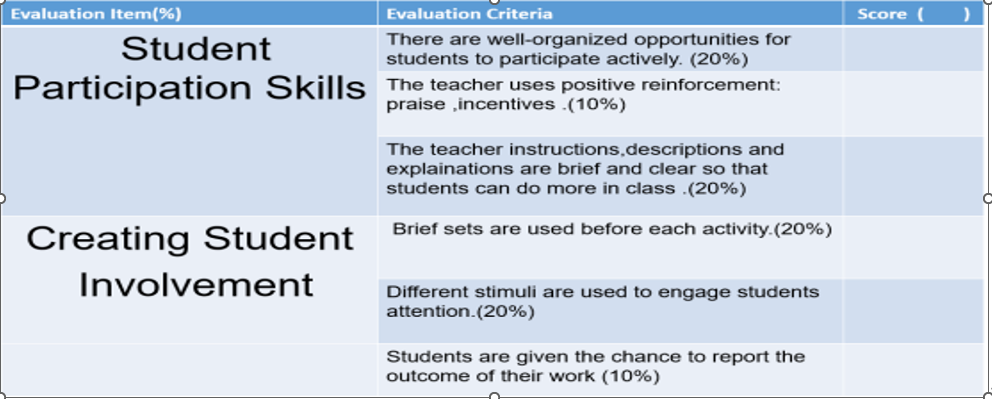
第三模块(Classroom Management)教学设计
一、教学内容:Instructions and Grouping
二、讲授学时:2
三、教学目标
(1) To know what classroom management is
(2) To discuss teachers’ roles
(3) To know the rules for giving class instructions
(4) To know the common ways of students’ grouping
四、教学主要知识点及教学重点、难点
What are the rules that novice teachers can follow to make instructions effective?

五、教学过程与教法设计
(1) PWP model
(2) Discussion questions followed
六、课程思政映射与融入点
Moral learning: How to design activities to lead student teachers to notice the way the demo teacher cultivate pupils’ outlook combined with the topic of the lesson.
七、课后任务
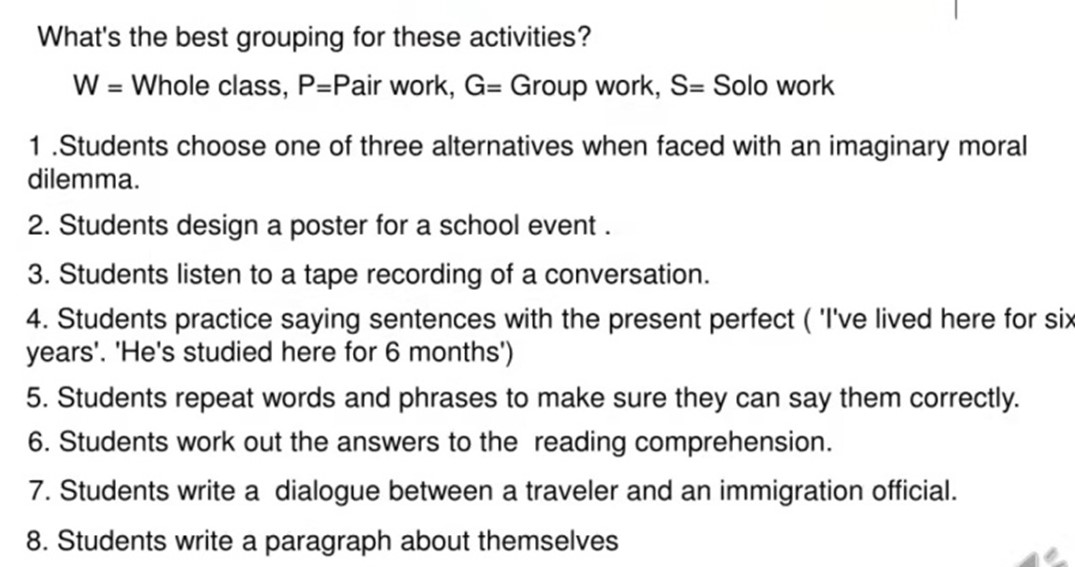
第四模块(Demo class)教学设计
一、教学内容:Demo class
二、讲授学时:2
三、教学目标
Get to know different factors related with classroom management
(1) To know what classroom management is
(2) To know how to present yourself effectively as a teacher
(3) To know different ways for student grouping,classroom interaction patterns
四、教学主要知识点及教学重点、难点
What interaction patters can you notice from the demo class?
(1) How does the T lead in to the topic of Today’s lesson?
(2) What’s learning skills the T focused on in this lesson?
(3) What is the moral value delivered by the T?
(4) How does the T move to the first listening task? Is it natural?
(5) How does the T design the set for the first pair work?
(6) Why did the T talk about her pet gold fish?
(7) What is the purpose of using a game in the middle of a lesson?
(8) Is the moral value taught naturally and embedded in the lesson as a whole?
(9) Which classroom interaction pattern is widely used in the lesson? And which one or ones are rarely used?
(10) Is it a CLT or TBLT lesson?
五、教学过程与教法设计
(1) TBLT model
(2) Discussion questions followed
六、课程思政映射与融入点
Moral learning:By observing the demo class, students will see how the demo teacher combined the topic “Animals” with “Animal Protection". Love nature,love animals and love life are the moral value.
七、课后任务
Please observe the demo class and evaluate upon the ways (interaction patterns) the teacher organizes her lesson
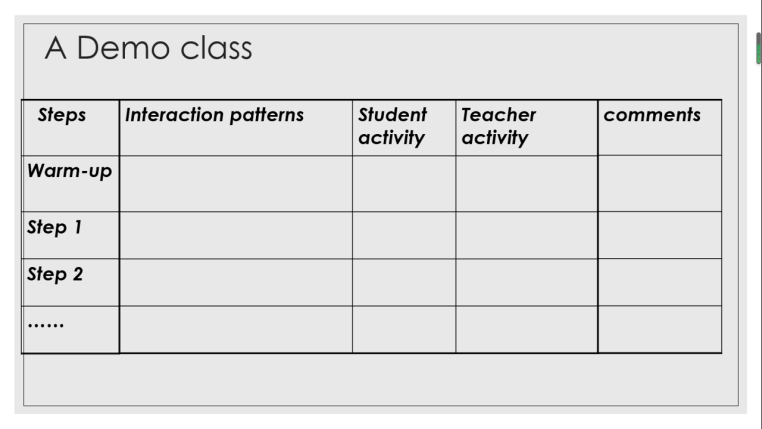
课后任务参考回答 Demo class analysis(T=teacher; ss=students) |
Steps |
Interaction patterns |
Student activity |
Teacher activity |
Comments |
Lead-in |
W |
Listen to the T |
Introduces herself to ss |
Leading to short forms and symbols |
Step1 |
W |
Give examples the short forms from their daily life |
Writes down ss’ examples and leads students to read them |
Letting ss relate short forms with their personal experience |
Step2 |
S /W |
Do the activity on the book(write the short forms) |
Monitors and checks ss work |
Drawing ss’ attention to the accuracy of the short forms |
Step3 |
S /W |
Listen to and write down Ji Ji’s talk on“Info about Jack”--task 1 |
Checks ss answers together |
Listening and writing skills are combined. |
Step4 |
P/W |
Talk and write about Jack’s friends in pairs-task 2 |
Checks ss answers together |
Speaking and writing activity are naturally linked with task 1 |
Step5 |
W/S |
Listen ,repeat and write symbols |
Tells ss a personal story “Pet Gold Fish”to elicit new short forms(part b write correct symbols) |
Switching from short forms to symbols smoothly |
Step6 |
W |
Play a game and work out problems |
Checks ss’ answer one by one |
Consolidating knowledge in a fun way |
Step7 |
S/W |
Rewrite part C(a short passage about Zhalong) to use the short forms and symbols |
Monitors and checks ss’ answers |
Applying what ss have learned in an integrated(read and write) way |
Step8 |
S/W |
Read part C two more passages (a bear and a panda)and take notes |
Uses a pre-made chart to check students’ answers |
Using a pre--made chart to facilitate learning directly and interactively |
Step9 |
G |
Discuss how to introduce Pan Pan to American ss -task4 in groups |
Facilitates ss’ reports by groups and prompt answers from ss |
Using group discussion to consolidate the knowledge as a whole |
Step10 |
W |
Watch a Video (Jackie Chan) |
Uses questions to lead ss to watch. |
Summarizing the moral value of the lesson with a video -Loving animals |
Step11 |
W |
Revise what have learned;work out more short forms; Search more examples |
The T gives the hw |
Assigning reinforcing and exploratory hw
|
Discussion questions:
There are some problems we are sure to encounter in teaching. What could be your possible solutions?
l The class may be too large.
l The group work does not go smoothly.
l There are some discipline problems.
l We are forced to deviate from our lesson plans.
Please reflect: In your primary or middle school, how many students were there in your class? Was it considered a large class? How did your teachers organize the class?What do you think of their techniques? What can you learn from then and what do you think can be improved?
第五模块(Discipline)教学设计
一、教学内容:Discipline in language classroom
二、讲授学时:2
三、教学目标
To know what discipline is
To know how to maintain discipline in the classroom
四、教学主要知识点及教学重点、难点
What is your understanding of a disciplined classroom?
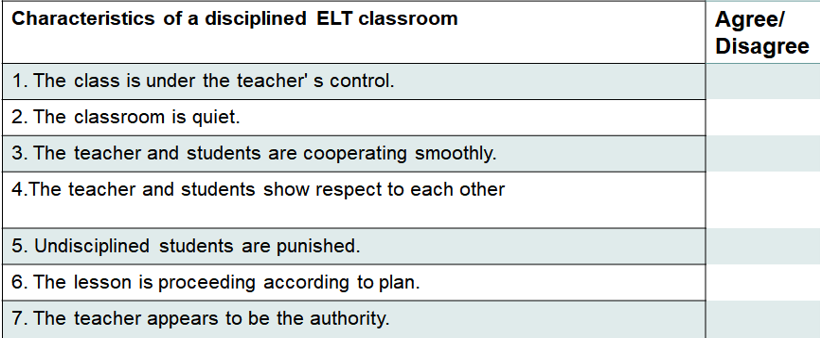
五、教学过程与教法
(1) TBLT model
(2) Discussion questions followed
六、课程思政映射与融入点
Moral learning:It is important to let students know that to manage the discipline well they need to set a good role model for the pupils.As a teacher ,he or she needs to be devoted so that students will be engaged in the class activities.Walking around and maintaining students attention can be crucial for classroom management.Projection of voice can also help.All these require students to be committed to teaching design.
七、课后任务
(1) To work out your solutions to the four situations listed above
(2) To sum up the discipline strategies that the teacher uses in his /her class in the videos given.
Discussion questions:
第六模块(Dealing with Errors)教学设计
一、教学内容:Dealing with Errors
二、讲授学时:2
三、教学目标
(1) To know different types of errors
(2) To identify error sources
(3) To discuss fluency and accuracy
四、教学主要知识点及教学重点、难点
What errors do learners make?
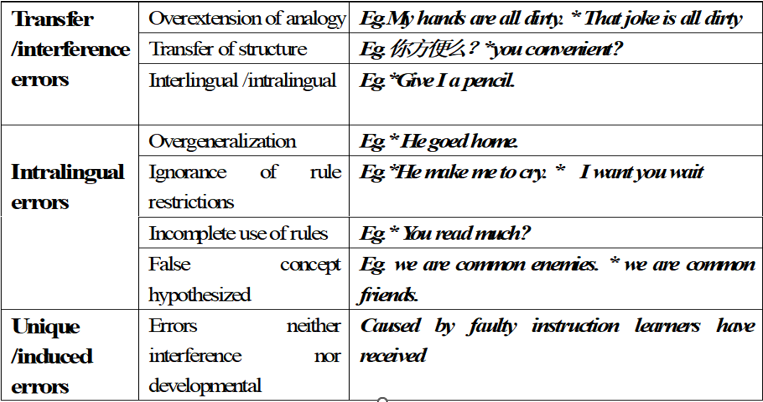
五、教学过程与教法
PWP model
六、程思政映射与融入点
Moral learning:It is important to let students know that making mistakes are inevitable part of learning.As a teacher ,he or she needs to realize that without trials and errors students won’t be able to learn the target language well. Just like in our life, we will gain in wit after we fall in a pit.
七、课后任务
1.Translate the sentence :
Accuracy-based courses that aim at total accuracy never produce candidates with total accuracy. On the contrary, they turn out no small number of very inaccurate candidates with total accuracy.
2. Do the task on P 82 and get to know next topic—questioning strategies in classroom.
第七模块( Questioning )教学设计
一、教学内容:Questioning Strategies
二、讲授学时:2
三、教学目标
1. To get to know different types of questioning.
2. To get to know Bloom’s Taxonomy
3. To talk about questioning skills
四、教学主要知识点及教学重点、难点
Key points:
Classification of questioning types :
Closed and open questions
Display questions and genuine questions
Lower-order and higher-order questions
Difficult points:
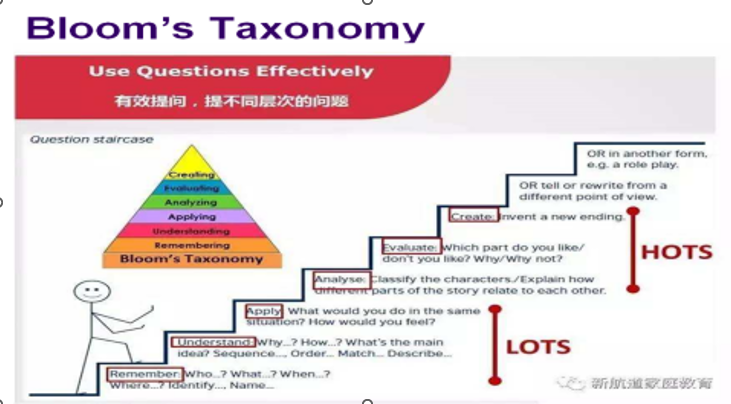
五、教学过程与教法
PWP model
六、课程思政映射与融入点
Moral learning:It is important to let students know that questioning techniques are crucial for language teachers .As a teacher ,he or she needs to realize without teachers’ intriguing questions, students motivation on learning won’t be evoked. Only with good teaching method can students learn better.
七、课后任务
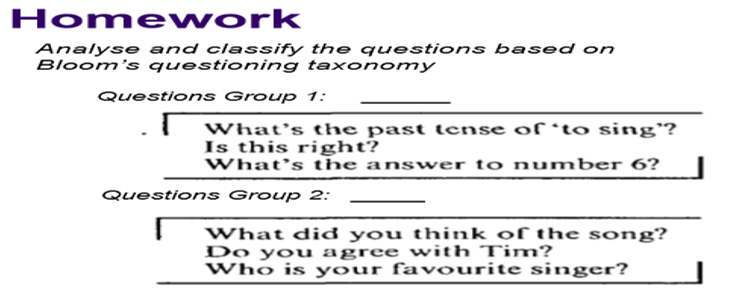
第八模块(Questioning)教学设计
一、教学内容:A Demo class for Questioning skills
二、讲授学时:2
三、教学目标
1. How can teachers improve their question skills?
2. Questioning skills
四、教学主要知识点及教学重点、难点
Key points
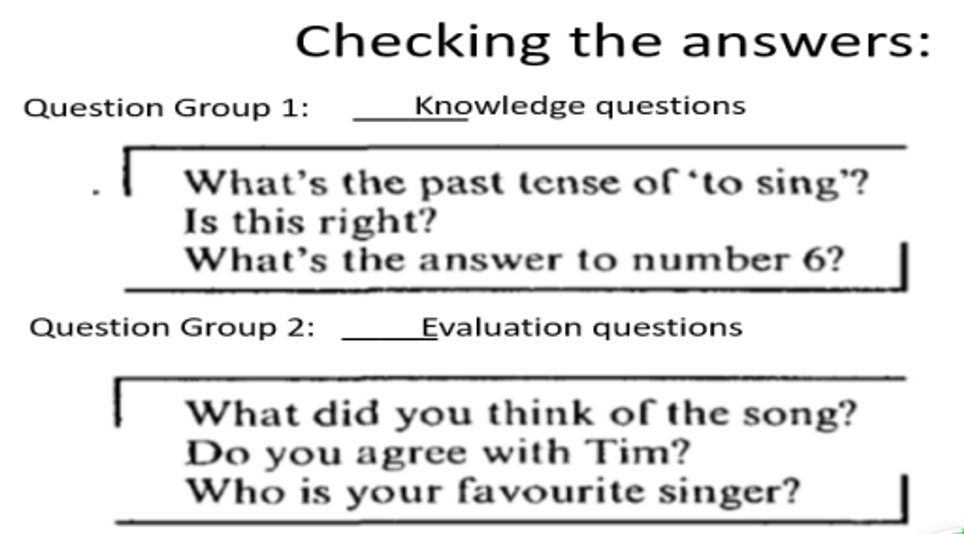
Difficult points:
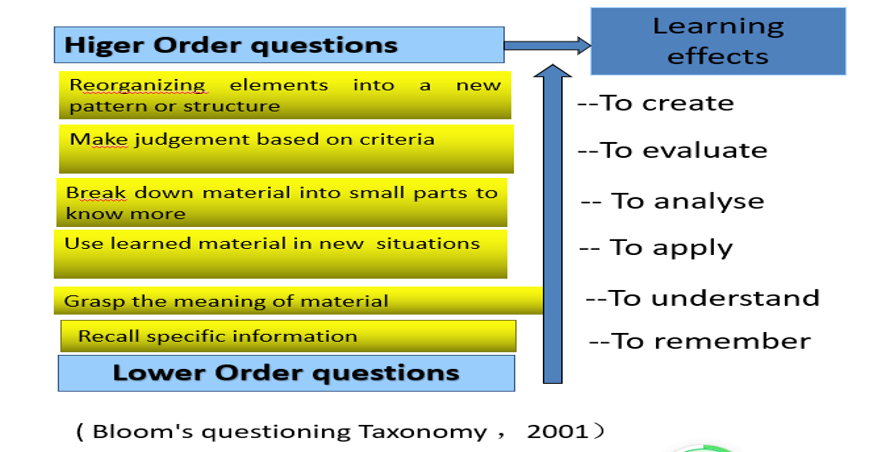
五、教学过程与教法
PWP model
六、课程思政映射与融入点
Moral learning:It is important to let students know that questioning techniques are crucial for language teachers .As a teacher ,he or she needs to realize without teachers’ intriguing questions, students motivation on learning won’t be evoked. Only with good teaching method can students learn better.
七、课后任务

Possible answers for the homework:
Types of question |
Examples from the video |
Comments |
a. Knowledge questions |
1. Who can read the first one? 2. Do you know how to spell fantastic? 3. What’s sports thing do you have? |
This is the kind of question that leads to the topic of the lecture, that checks students' pronunciation, etc. |
b. Comprehension questions |
1. Does Frank have a soccer ball? 2. Who has a soccer ball? 3. Who do Frank and Ellen play soccer with? |
This kind of question is not difficult for students, can examine the students' understanding of the text. |
c. Application questions |
1. What do you often do enrich your life? 2.Try to make a sentence to use” It is… to play … with friends.” 3. Who can make these two sentences into one sentence? |
This kind of question is very necessary. Sometimes it may be difficult for some students to test their English ability. |
d. Analysis questions |
1. What does he think of ping-pong? 2. How do you know the answer? 3. Why doesn’t she play sports? |
This kind of question is more challenging whcih can let the student express their own opinions according to the article. |
e. Evaluation questions |
1. Who is good at soccer in our class? 2. Who do you think will be the super stars in our class?
3. What’s sports do you play? And what do you think of it? |
This kind of question is very flexible in nature and requires students higher levle of thinking ablility, Students can express freely . |
f. Creation questions |
1.Write down your own answer to “Do you have a soccer ball?” (write down your own story.) 2. Six students are in one group. Try to invent a new ball of change rules. |
This kind of question is more enlightening and examines students' creativity and imagination. |
第九模块( Teaching Pronunciation )教学设计
一、教学内容:Teaching Pronunciation
二、讲授学时:2
三、教学目标
1.To know the goal of teaching pronunciation
2. To know the aspects of teaching pronunciation
3. To know the ways of improving students’ pronunciation
四、教学主要知识点及教学重点、难点
The realistic goal of teaching pronunciation:

Ways of practicing sounds:
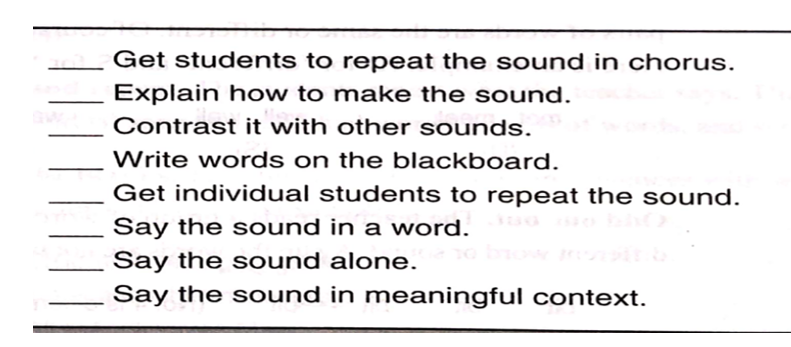
五、教学过程与教法
PWP model
六、课程思政映射与融入点
Moral learning:It is important to let students know that native-like accent is not realistic for Chinese English learners who have no natural learning environment. So it is OK to speak in a Chinese accent, we should not be shy.
七、课后任务
What do you think are the problems in Mr. Ma’s approach to teaching pronunciation?
第十模块( Teaching grammar )教学设计
一、教学内容:Teaching grammar
二、讲授学时:2
三、教学目标
1.To know the role of grammar in language learning.
2. To know the major types of grammar presentation methods.
3. To know some of the grammar practice activities.
4.To get to know task-based grammar activities
四、教学主要知识点及教学重点、难点
Grammar presenting methods
The deductive method:The teacher explains grammar rules in sts’ native language and asks sts to practice with given prompts. Problems with deductive teaching:
The inductive method:The teacher provides learners with authentic language data and leads the sts to realize grammar rules without any form of explicit explanation. (the teacher may elicit the grammar rule from the sts) Examples for inductive method: P105
The guided discovery method
How different are the guided discovery method and the inductive method? P105
五、教学过程与教法
PPP
六、课程思政映射与融入点
Moral learning:It is important to let students know that Grammar learning is to learn the language in contexts.As a teacher, she needs to guide the students to find the rules rather tha cram them with rules.So grammar lessons can be interesting too.
七、课后任务
Homework
Suppose you are about to teach a grammatical structure. What should you do when facing structures that can be easily perceived? and structures that are not easy for learners to discover? Using examples to explain.
第十一模块( Teaching Vocabulary )教学设计
一、教学内容:Teaching Vocabulary
二、讲授学时:2
三、教学目标
1. To know what to teach in terms of vocabulary .
2.To become familiar with interactive vocabulary activities that engage and involve learners.
3. To teach vocabulary learning strategies.
四、教学主要知识点及教学重点、难点
Hedge (2000), vocabulary learning involves the two aspects of meaning. The 1st aspect involves the understanding of its denotative and connotative meaning. The 2nd aspect involves understanding the sense relations among words.
Denotative meanings: refer to those words that we use to label things as regards real objects, such as a name or a sign, etc. in the physical world.
Connotative meanings (affective meanings): show people’s emotions and attitudes towards what the word refers to.
五、教学过程与教法
PWP
六、课程思政映射与融入点
Moral learning:It is important to let students know that vocabulary teaching need to be combined with contexts. Daily and personal neccessities are what students can retain in their memory, so teachers can teach some cognitive learning strategies to boost students’ learning.
七、课后任务
Homework
Observe the uploaded video clips and practice vocabulary building activities in your teaching.
第十二模块( Teaching listening )教学设计
一、教学内容: Teaching listening
二、讲授学时:2
三、教学目标
1.Get to know the differences between classroom listening practice and real life listening
2.Get to know the principles for teaching listening
3.Get to know the models for teaching listening
4.Get familiar with common listening activities
四、教学主要知识点及教学重点、难点
1. Why does listening seem so difficult for students?

2.Bottom-up model
This process of listening expects the listener to have a very effective short-term memory as they have to make sense of every sound in order to figure out the meaning of words, phrases, and structures.
3.Top-down model
In this model, listening for the gist and making use of the contextual clues and background knowledge to construct meaning are emphasized
五、教学过程与教法
pwp六、课程思政映射与融入点
Moral learning:It is important to let students know that listening is the key to language learning.Motivating listening activities can stimulate students’ learning interest.Guided discovery method is to guide students to find their own learning pace and learn effectively.
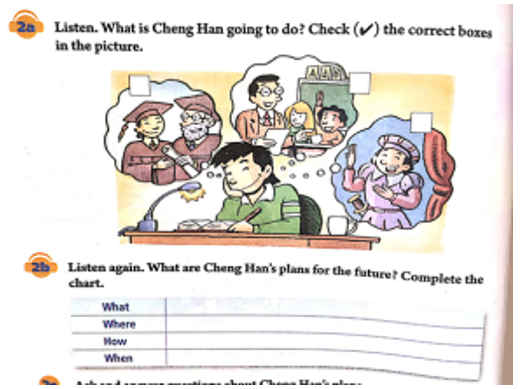
七、课后任务
Homework
Analyze the following exercises to see if they are top-down or bottom-up, give reasons.
第十三模块( Teaching Speaking)教学设计
一、教学内容:Teaching Speaking
二、讲授学时:2
三、教学目标
1.Features for successful speaking tasks
2. Principles for teaching speaking
3. Types of speaking tasks
4. Speaking activities
四、教学主要知识点及教学重点、难点
Features for successful speaking tasks
1) Right language level P157
(common features of spoken lagnauge)
Maximum foreign talk (Task 2 How do we promote talking?)
Even participation
4) High motivation (Engagement)
Types of speaking tasks
Structural activities e.g. focused structural dialogues, controlled role play
Pre-communicative tasksP162
Communicative tasks
Social interaction activities e.g. problem-solving, discussions, debate , interviews…
五、教学过程与教法
PWP
六、课程思政映射与融入点
Moral learning:It is important to let students know that speaking activities need to be related with studnets personal lives.When designing speaking activity, extented time is required to let students full participated in classroom activities.
七、课后任务
Read the following case of oral teaching, analyse its shortcomings and give suggestions on how to resolve the problems.
In a speaking lesson about invitation, the teacher first presented the target language of invitation on the screen and asked his students to read and repeat the target language three times, and then showed a video that modelled the target language. At the end of the lesson, he asked the students to role-play the dialogue presented by the video.
第十四模块( Teaching Reading )教学设计
一、教学内容: Teaching Reading
二、讲授学时:2
三、教学目标
1. What to & how to read?
2. Objectives of teaching reading
3. Principles for teaching reading
4. Models & stages for teaching reading
5. An example of teaching reading
四、教学主要知识点及教学重点、难点
Three stages in teaching reading
1) Pre-reading stage
2) While-reading stage
3) Post-reading stage
Types of texts:
Continuous texts
Non-continuous texts
Models for teaching reading:

六、教学过程与教法
PWP
六、课程思政映射与融入点
Moral learning:It is important to let students know that reading teaching is a good way to let student get a complete experience with
七、课后任务
Design some pre-reading activities for the passage below taken from PEP Book 5 Unit 2
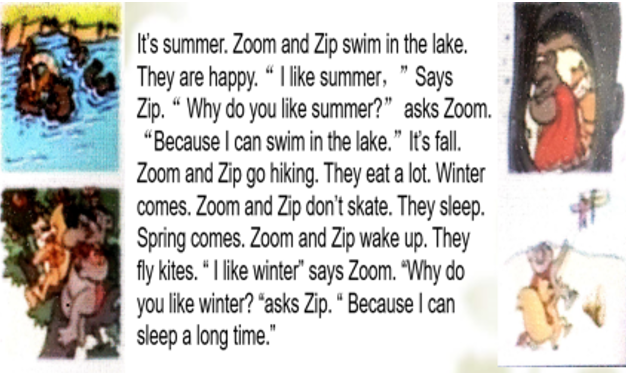
第十五模块( Teaching Writing )教学设计
一、教学内容:Teaching Writing
二、讲授学时:2
三、教学目标
四、教学主要知识点及教学重点、难点
1. get to know the problems in writing tasks
2. understand the features of communicative approach to writing
3. be able to set up tasks for different stages of the writing process
Problems in writing tasks
They are mainly accuracy-based.
They are designed to practice a certain target structures.
There is insufficient preparation before the writing stage.
There is no sense of audience.
Features of communicative approach to writing
Communicative purpose
Communicative desire
Content, not form
Variety of language
No teacher intervention
No materials control
五、教学过程与教法
PWP
六、课程思政映射与融入点
Moral learning:It is important to let students know that writing in a process-oriented way is more benefitial for students regarding the development of their thinking ability rather than rote learning ability.The process might be long and time-consuming, but it is worth it in a long run.
七、课后任务
[ Case Reflection]: Mr. L pays a lot of attention to English writing. He gives writing assignments every week to his students , and sometimes a writing task after a class discussion. According to him, continuous writing practice is the best way for students to improve their writing skills. He corrects each mistake in his students' essays and asks them to rewrite them. However, his students continue to make many mistakes in their essays and the work they hand in is not satisfactory. What do you think are the problems with Mr. L's teaching?
第十六模块(Learners’Individual Differences)教学设计
一、教学内容:Learners’Individual Differences
二、讲授学时:2
三、教学目标
1.Get to know different learning styles
2.Identify your own learning styles
3.Objectives of the lesson:P262
四、教学主要知识点及教学重点、难点
Visual learners
B. Auditory learners
C. Tactile learnersD. Kinesthetic learners E. Group learners
F. Individual learners G. Authority oriented learners
H. Reflective learners Understanding learner differences
Match FD and FI styles with the styles on
FD |
FI |
Personal oriented |
Impersonal oriented |
holistic |
Analytic |
dependent |
independent |
Socially sensitive |
Not socially aware |
五、教学过程与教法
PWP
六、课程思政映射与融入点
Moral learning:It is important to let students know that to know learners’ differences is essential in designing classroom activities. Based on students’ needs and personal diversity, teachers can make the lesson more meaningful and useful for students.
七、课后任务
Homework: Identify your learning styles
第十七模块( Learner Strategies )教学设计
一、教学内容: Learner Training
二、讲授学时:2
三、教学目标
四、教学主要知识点及教学重点、难点
1.Get to know brain functioning and Multiple intelligence
2.Get to know different (cognitive) learning strategies
3.Get to know different affective variables
五、教学过程与教法
Left and right Brain dominance
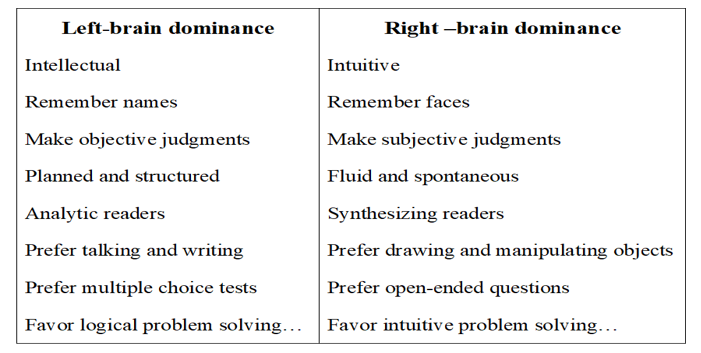
What do the examples try to guide us to train our learners in terms of learning strategies?P275-282
Involve students in an overview of the textbook at the beginning.
Involve students in finding out about themselves.
Use learner diaries as a way to help student reflect on their learning.
Guide student to make plans for learning.
六、课程思政映射与融入点
Moral learning:It is important to let students know that students are all intelligent in their own ways.When we design class activities, we are supposed to take their personal cognitive styles into consideration.
七、课后任务
Did you receive any learning strategy training in previous English study? What was the training like? Can you give examples and classify them into the four types of strategies we mentioned today?
第十八模块(Revision)教学设计
一、教学内容:Revision
二、讲授学时:2
三、教学目标
Revision of the following topics:
Instructions and Grouping
Discipline in language classroom
Dealing with errors
Questioning
Teaching pronunciation
Teaching grammar
Teaching Vocabulary
Teaching listening
Teaching Speaking
Teaching Reading
Teaching Writing
Learner Differences
Teaching learning strategies
四、教学主要知识点及教学重点、难点
Major points concerning language teaching pracitice in class will be covered briefly
Necessary excercises will be designed to check students’ comprehension.
五、教学过程与教法
PPP
六、课程思政映射与融入点
Moral learning:It is important to let students know that to be good language teacher is not easy. It takes skills and constant practice. Only by dilligent study and persistant work can one become a qualified teacher.
七、 课后任务
Homework: Revision of the stuff that we have learned in the whole semester.